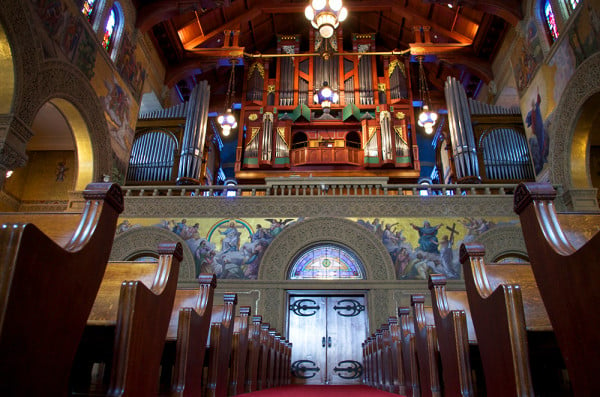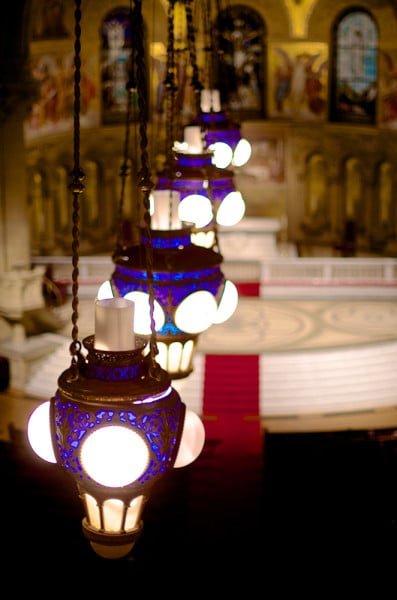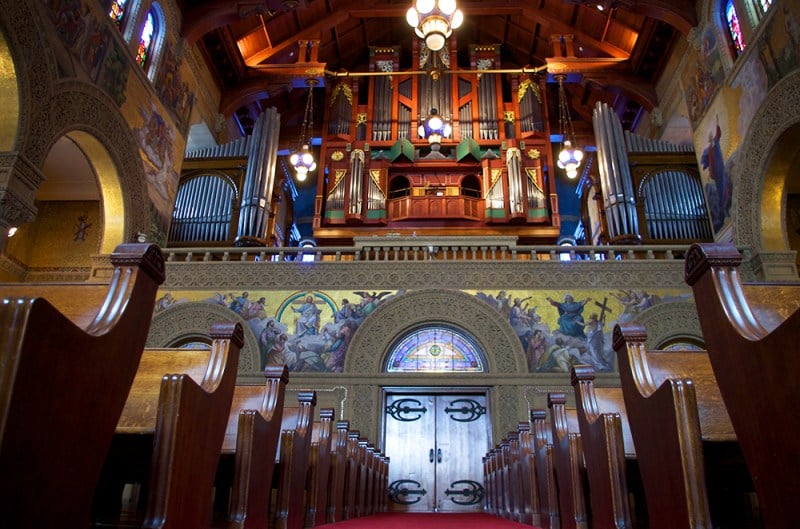At 2 p.m., the afternoon sun begins to illuminate the stained glass windows behind the altar, casting a warm light onto the chancel of Memorial Church and its colorful murals and ornate architecture. The countless ceiling tiles sparkle under the glow.

The elaborate Victorian church hasn’t, however, always been a scene of tranquility. MemChu, as it is fondly referred to, has a rich history, replete with weddings, memorial services and religious congregations but also earthquakes, reconstruction and even a bizarre murder.
Memorial Church recently celebrated 111 years since its Jan. 25, 1903 dedication. According to docent Susan Christiansen ‘60 M.A. ‘ 61, Jane Stanford built the church in memory of her late husband and intended it to be the focal point of campus.
“It serves as a core part of the University, and its location symbolizes that,” Christiansen said. “The Stanfords felt very strongly that the spiritual component of your education was as important as the academic.”
Quake and Break
Just two years after the dedication in 1905, Jane Stanford died and was subsequently honored in a funeral held at MemChu, a distinction that was later shared by the likes of iconic football coach Bill Walsh and Apple CEO Steve Jobs.
The church building had only been standing for three years before the massive San Francisco earthquake of 1906 struck and devastated it, as the church lacked the tough steel infrastructure of modern buildings. The 85-foot spire that rested atop the original Memorial Church collapsed into the church, wrecking the interior. The original frontal façade wholly collapsed into the Quad.
“Luckily, Mrs. Stanford didn’t live to see that happen,” Christiansen said.
It was not until 1913 that repairs were finished, after workers painstakingly numbered and replaced each fallen block. The new church bore marked differences from the original. Several white marble statues of apostles on the chancel were lost. The steeple was never rebuilt, though the clockwork and face from one clock on the steeple were restored and can still be seen in the Clock Tower on Lasuen Mall.

A second major earthquake in 1989 did less, though still severe, damage. Stanford incurred costs of $10 million to repair fallen arches, railings and mosaics, , said Christiansen. Remarkably, the stained glass windows visible today in Memorial Church survived both the 1906 and 1989 earthquakes intact, even while surrounding structures crumbled.
Earthquakes haven’t been the only misfortunes to affect the church, however. In 1974, a Stanford police officer locked the doors to Memorial Church and returned the next morning to discover both an unlocked door and the dead body of Arlis Perry, a 19-year-old North Dakota resident who had come to California to marry Stanford student Bruce Perry ‘77. A Santa Clara County spokesperson later told The Daily that the case was “definitely a sex crime,” but that suspicions of a murderous cult at work were unfounded (“No Suspects Yet in Murder Case,” Oct. 15, 1974). The homicide has not yet been solved.
On the Bright Side
Funds used to repair the church after the 1989 earthquake were largely provided by couples that got married at Memorial Church before the disaster, said Memorial Church wedding coordinator Melissa Prestinario. Such large-scale fundraising was possible because over 8,000 couples have been wed within the church walls.
Memorial Church hosts anywhere from 80 to 150 marriages each year, she said, with couples ranging from Palo Alto residents to people living in Singapore, New Zealand and Europe who wanted to return to their alma mater. Each wedding is recorded in a registry that contains documentation of every marriage ceremony since the first in February 1903, just weeks after Memorial Church opened its doors.
The church’s organs have also played a significant part in its history. University organist Robert Morgan has played organ for many of the weddings, Sunday services and funerals held at Memorial Church in the past 14 years.
What most people don’t realize, according to Morgan, is the church owns five separate organs from different time periods. The network of pipes in the back gallery above the entrance is actually made up of two separate instruments, and there are three additional organs in the side chapel. One instrument, a Baroque organ by Charles Fisk, was so large and heavy that renovations were needed in order to safely install it in the rear gallery of the church in 1983. The newest addition, a Tudor English organ, was built specifically for Morgan’s use. Morgan and guest performers use the five instruments to play music in a historically accurate fashion.
“Certainly, in this country, nothing approaches what we’ve got here,” Morgan said of the organs’ quality and number.
Memorial Church has evolved to an extent that Jane Stanford probably did not anticipate. What started as a nondenominational Christian church now holds regular multi-faith services —Christiansen noted that there have been traditional Hindu and Buddhist weddings in addition to Christian and Jewish ones.
Nor is it solely religious anymore: as student protests against the Vietnam War erupted across the nation in the late 1960s, the church did not rebuff angry students, but instead invited them to meet within the church and express their frustrations.
Aesthetically beautiful, resilient after disaster and ever accommodating, Memorial Church is what Prestinario calls “the crown jewel of Stanford.”
Those interested in learning more about this historic building may attend weekly tours on Fridays at 2 p.m., led by the docents of Memorial Church.
Contact Victor Xu at vxu ‘at’ stanford.edu.
